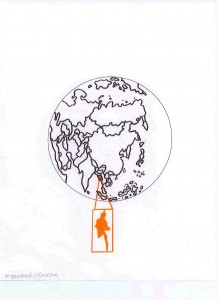MYANMAR
A. THE COUNTRY
The Union of Myanmar, in southeast Asia, is divided into seven regions
(dominant ethnic groups) and seven states (particular ethnic
minorities). The military-led State Peace and Development Council was
dissolved after nearly 5 decades in power, and a Presidential civilian
government inaugurated in 2011. The corrupt regime had both pillaged
and stunted the economy. Myanmar has teak forests, fertile soil for
agriculture (mostly rice), precious gems and minerals, and offshore oil
and gas deposits, but most people live in poverty or at subsistence
levels. Amphetamines replaced opium as the illicit drug of choice and
these are exported primarily across the Thai border.
B. THE PEOPLE
The population is ~50,496,000 and official language Burmese. There are
eight major national races and (officially) 135 sub-groups and tribes.
There are many more smaller tribes and language groups. The government
had deliberately underestimated minority ethnic populations, and there
are no reliable census figures since 1931. ~78.7% are Tibetan-Himalayan,
~14.8% Southeast Asian, ~4.2% South Asian, ~2.3% Other (Chinese).
The country continues to struggle to overcome its ethnic tensions.
Intravenous drug use is widespread and closely linked to HIV/AIDS, with
about 1.5% of the population infected.
In 2008, cyclone Nargis devastated the country and 140,000 people lost
their lives from the storm itself and from disease and deprivation.
In Thailand alone there are over 2 million Burmese (mainly for economic
reasons), and more in Malaysia, Singapore and Western nations. Another
million are internally displaced, mostly from Christian areas.
C. RELIGIONS AND CHRISTIANITY/PENTECOSTALISM
The regime recognized the special status of Buddhism in Myanmar.
Freedom of religion exists, at least according to the constitution.
~80.04% are Buddhist, ~8.98% claim to be Christian, ~7.2% Muslim, ~2.3%
Chinese, ~0.63% Ethnoreligionist, ~0.45% Hindu, ~0.4% Non-religious.
Numbers for minority religions are certainly larger than what the former
regime’s figures state. In the Christian category:
~4.52% are Protestant, ~2.29% Independent, ~1.33% Catholic, ~0.68%
Unaffiliated, ~0.13% Anglican, ~0.03% are considered ‘marginal’.
Evangelicals represent ~5% of the population.
Charismatics represent ~1.4% and of those ~0.5% are Pentecostals.
Donna Siemens
References:
http://en.wikipedia.org
Operation World, Jason Mandryk. Colorado Springs: Biblica Publishing, 2010.

